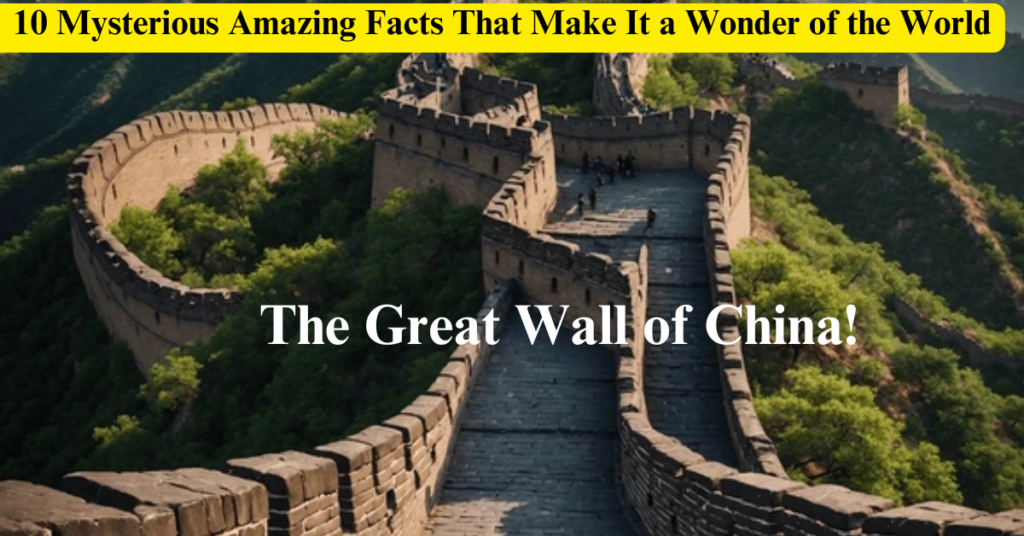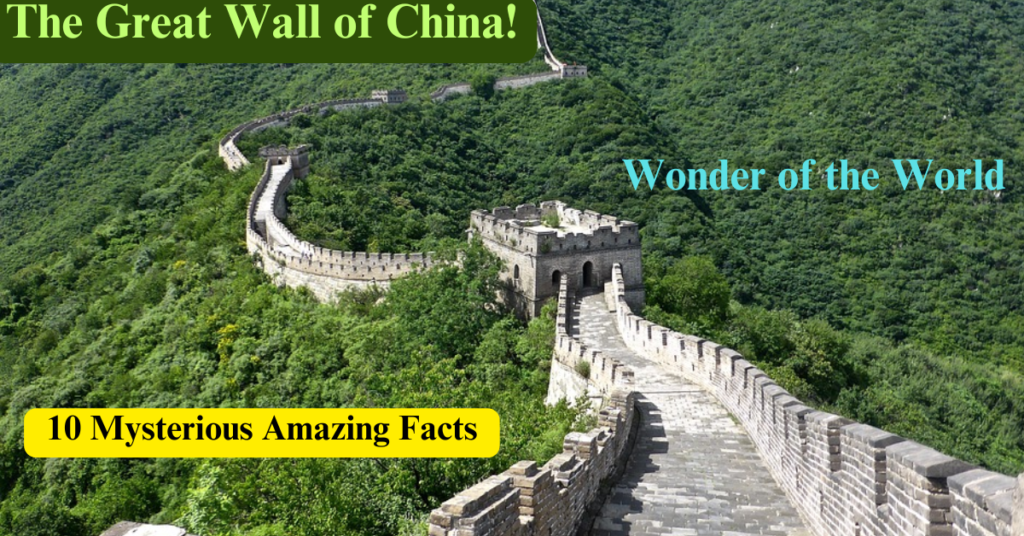
Table of Contents
Amazing! 10 mysterious facts that make the Great Wall of China a wonder of the world
The Great Wall of China, known in English as “Great Wall of Chinahttps://simple.wikipedia.org/wiki/Great_Wall_of_China“, is considered to be the largest and unique man-made structure. This wall is not only the historical and cultural heritage of China, but it is an example of such amazing architecture and technical skill, which the whole world has seen miraculously. This wall, about 13,000 miles long, was built centuries ago by various dynasties and empires for security and strategic purposes.
The Great Wall of China is not just a wall, but a symbol of humanity’s extraordinary hard work, patience, strategic understanding and foresight. This wall was not only built to protect the border of China, but it has also become a symbol of China’s cultural identity and power. Today it is a wonder for the whole world, which presents a wonderful example of architecture and human courage.
In this article, we will understand through 10 amazing facts how the Great Wall of China became the world’s largest and mysterious construction, and why it remains a historical wonder.
- Not actually a wall, but a network
We think of the Great Wall of China as just a wall, but it is actually a huge military network, consisting of walls, bastions, forts and ramparts. It was not just a wall, but an organized network of various structures, built by several dynasties. It was constructed at different times and added to by different empires and dynasties.
Initially it was built as small walls, but later it was connected with strong and huge forts and bastions, so that it could be completely secure. This wall passes through the entire northern region of China and it changed according to different geographical areas.
The Great Wall of China that we see today is primarily part of the walls built by the Ming Dynasty, but it is a much larger structure, a network of many forts, strongholds, and watchtowers.
- Construction by multiple empires and dynasties
The Great Wall of China was built by multiple empires and dynasties. Its purpose was to protect China’s northern border, especially from Mongol and other invaders.
The first construction of the wall began in the 7th century BC, when the Zuo Dynasty began building it. However, its actual construction and expansion took place during the reign of Emperor Shi Huangdi of the Qin Dynasty. Shi Huangdi unified China in 221 BC and took steps to strengthen the wall. He added walls and strengthened it completely to protect against northern invaders.
The major construction of the wall took place during the Ming Dynasty, when the work of building it with bricks and stones increased rapidly. The wall was further strengthened during the Ming dynasty, to protect against invaders such as the Mongols.

- The 13,000-mile-long wall
The total length of the Great Wall of China is about 13,000 miles (21,000 kilometers). It runs all along the northern border of China and has different sections that vary in length. Some sections are quite short, while some sections are huge and extensive. The wall passes through about 15 provinces of China and sees many regional variations, which were made according to different geography and strategic needs during its construction.
Being the largest wall in the world, millions of laborers and artisans worked in its construction. At the time of the wall’s construction, it played a very important role in the defense of China, as it simultaneously served as a network of many strongholds and forts, capable of stopping any invasion.
- The construction material of the wall varied from region to region
The Great Wall of China was built from different materials, depending on the geographical and environmental conditions of the particular place. Some parts of the wall used materials such as mud, wood and bamboo, while other parts used stone and bricks.
In the northwestern regions, where the environment was harsh and materials were scarce, the wall was built from mud. In Mongolia and other rugged regions, stone and bricks were used to strengthen the wall. During the Ming Dynasty, when the wall was renovated, most of it was built from strong bricks and stones.
- Military structure and security
The Great Wall of China was not just a simple wall, but it was a large military structure, capable of protecting China’s northern border. It had a variety of security facilities, such as sentinel posts, archways and stopping places for soldiers.
The watchtowers built into the wall helped soldiers keep an eye on the movements of invaders. Archers were provided with space on the upper part of the wall so that they could shoot arrows at the enemy from a distance. Apart from this, bastions and forts built in the wall were used as safe places where soldiers and citizens were given refuge.
- Sacrifice of countless workers
The construction of the Great Wall of China was a very difficult and laborious task. Millions of workers worked in it and many workers also lost their lives during the construction of the wall.
Many historians believe that thousands of workers died during the construction of the wall due to difficult conditions and exhaustion. According to some historians, the dead workers were buried in the wall. Every part of the wall bears testimony to a living sacrifice and it reminds us of the countless struggles and sacrifices associated with the wall.
- Sites within and around the wall
There are many historical and religious sites within and around the Great Wall of China, which further enhance its historical importance. Religious and cultural activities took place in many forts and strongholds located near the wall.
These sites also included many temples and other religious sites, which reflect the religious beliefs and cultural traditions of that time. Apart from this, there were also many small villages and settlements around the wall, which reflected the life around the wall.
- Cultural Importance of the Wall
The Great Wall of China was not just a military structure, but it also became a symbol of China’s culture, power and unity. The purpose of building the wall was not only to protect against invaders, but it was also a part of China’s rich cultural heritage.
This wall is a symbol of China’s strategic vision and political unity. It not only served to strengthen China’s security, but it also preserved the social and cultural structure of that time.
- A Wonder Even Today
The Great Wall of China is still included in the seven wonders of the world and is recognized by UNESCO as a ‘World Heritage Site’. Today this wall remains a center of attraction for tourists from all over the world.
The Badaling section located near Beijing is especially famous, where most of the wall is well preserved. From here tourists can admire the vastness of the wall and understand its historical importance.
- The challenge of preserving the wall
Although most of the Great Wall of China is still preserved today, some parts have turned into ruins due to time and environmental changes. Grass and bushes have covered parts of the wall in some parts, making its preservation difficult.
The Chinese government and various historical preservation organizations are constantly making efforts to preserve this wall, so that future generations can also see this amazing structure and understand its historical significance.
Conclusion:
The Great Wall of China is not only a colossal architectural marvel, but it is a unique example of humanity’s collective courage, struggle and vision. This wall not only symbolized the military and strategic objectives of the time, but it also became a symbol of China’s cultural identity and national unity. The wall was not only built under harsh and difficult conditions, but it also contained the sacrifices of millions of laborers and the hard work of countless generations. Various parts of the wall, including forts, bastions, watchtowers and security systems, show that it was not just a wall, but a complete strategic structure, which not only protected China’s borders, but also strengthened the country’s internal security and social structure.
Various empires and dynasties contributed to the construction of this wall, which makes it even more historically important. This wall holds an indelible place in history due to its length, construction materials, construction methods and the sacrifices of those hard-working people. Over time, this wall was not only a military structure, but it became a symbol of China’s cultural heritage and national pride.
Today, the Great Wall is considered a wonder not only in China but all over the world. The steps being taken to preserve and maintain it prove that the Great Wall of China is not only a physical structure but also a living history that we have to protect and preserve for future generations.
The importance of the Great Wall of China lies not only in its historical and military aspects but also in its symbolism of the collective strength, dedication and unity of humanity. The wall teaches us how extraordinary things can be accomplished when a society unites and moves towards a goal. The wall is not only a national heritage of China but has also become a source of inspiration for the entire world, showing us how mental and cultural strength is required to overcome physical limitations.
In this way, the Great Wall of China is a living symbol that not only tells the story of China’s historical prosperity but also reminds us of the power of human courage, restraint and unity, which serves as an inspiration to face the challenges we face. This wall is not just a structure but a precious heritage that needs to be preserved and respected so that it can give future generations a deeper understanding of our history, struggle and collective inspiration.


